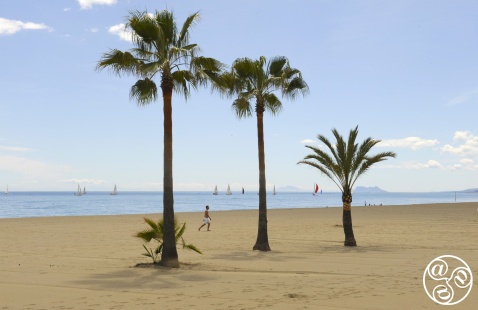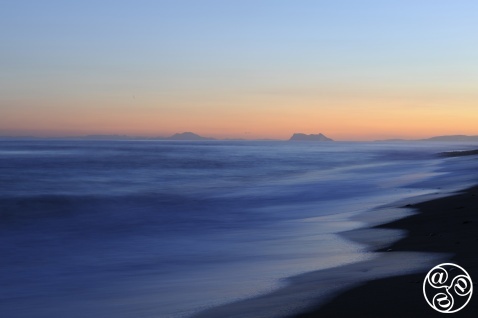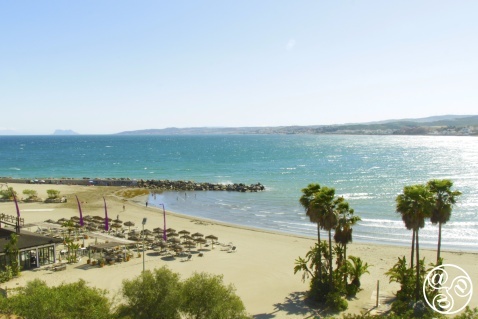
Playa La Rada, Estepona © Michelle Chaplow |
|
Estepona Beaches (West to East).
West to Casares beaches.
PLAYA de la GALERA
The Playa de la Galera (Galera beach) is located between Playa Bahía Dorada headland and the Torre de la Sal headland separating it from Playa de la Sal Casares. It is a coarse, dark-sanded, pebbled small beach with rocky areas measuring just 2K in length. Still, it offers visitors a relatively quiet area to enjoy sunbathing, swimming, or scuba diving.
The beach is known for Islote de las Palomas (Doves Islet) or Piedra Paloma (Doves rock), a small steep sided rocky islet just below the low-water mark. It is of particular interest to snorkelers and birdwatchers. It is not (sensibly) possible to climb on the islet although it is just possible to walk to it on a low tide.
The Islote de las Palomas also marks the Estepona / Casares municipal boundary. In some records the western half of Playa de la Galera is called Playa Paloma II or Playa de la Piedras de la Paloma. In 2016 is became an authorised Dog Beach replacing the Playa del Sal dog beach. Access to Playa Piedra Paloma is via the Urbanizacion Casares del Mar.
The main Playa de la Galera beach is accessible by car or on foot. There is limited parking on the here on the beach side of the coast road. Next to the petrol station, there is a over bridge that helps pedestrians to cross to the coast having parked their cars on the mountainside of the coast road. .
PLAYA BAHIA DORADA
This beach is similar to the others in the area. Bounded by the two headlands it is about 700m long and 40m wide. The established 1970s urbanization Bahia Dorada fronts the beach. A seafront promenade was constructed recently, to protect from land erosion in the winter storms. There is no car access to the beach. On the Bahia Dorada headland at the east and interestingly within the estate is the old 'Bahia Dorada watchtower (Torre Vigia).
PLAYA ARROYO VAQUERO
This beach is to the east of the Bahia Dorada headland, and where the Arroyo Vaquero river reaches the sea. The car access is a roundabout into the Estepona Spa and Resort Hotel which fronts this beach. there is car access to the beach with limited parking. Upon entering the urbanization infrom of the hotel entrance turn either left or right and wind your way through the houses down to the beach. The Arroyo Vaquero beach here is about 1km long and 50m wide and is quiet.
PLAYA COSTA NATURA
The beach is a continuation of Playa Arroyo Vaquero, however the 400m section in front of the Costa Natura resort is officially classified as 'naturist beach'. This naturist stretch of beach runs from the small headland at the eastern perimeter, in front of the Costa Natura Complex and inf ront of the adjacent 'The Edge' (2019) residential complex and Nido Beach Club (2021) to the Arroyo Enmedio stream. Like all beaches in Spain the beach open to all members of the public. You can rent sunbeds from Costa Natura where a small kiosk sells soft drinks. Nido Beach Club also offer luxury sumbeds but refuse naturists, a policy that has lead to dispute over rights and a change.org petition. Parking is available on the service road in front of Costa Natura and in the car park by The Edge. Access down to the beach is by footpath from either side of side of Costa Natura / Edge complex. More>
Costa Natura was Spain's first purpose-built naturist complex was granted rights in the 1970s and the present complex was constructed 1982 and extended in 1984. It is located to the east of Estepona town between the N-340 and the beach at km 151. The complex is mainly residential. Apartments are for available for holiday rental and a limited number of day passes are available for touring naturists.
PLAYA GUADALABON
This is the name given to various stretches of beach in the area of the river Guadalabon. Some areas, such as that in front of Gran Hotel Elba (with promenade walkway), or in front of H10 Estepona Palace Hotel, are wider, but much of the rest of this 2km seafront is not overly interesting. Generally this is a moderately quiet sand and pebble beach. While not directly accessible by car, there is parking nearby, and it is a relatively short walk to the beach. The beach is popular with divers and fishermen and is a quiet area to sunbathe, swim, or kayak. There are some showers but no toilet facilities. There are no chirinquitos (beach bars) along Playa Gudalabón.

(in the late 1990s when Estepona had police horses).
PLAYA DEL CRISTO
Situated just outside the town of Estepona, to the west of the Marina, El Cristo beach is situated in a delightful sheltered cove, ideal for children, with two chiringuitos. Its ideal location facing west means longer hours evening sunshine. This beach has become increasingly popular in recent years and tends to get quite crowded on summer weekends. It has a good atmosphere with music playing at two of the beach bars. The cove and the outer protection wall ensure the sea is warmer than the surrounding waters. It is also a favourite spot for winter sea-swimmers. It slopes very gently and is very safe for children. There is a lifeguard station and showers in the summer. There are two good beach bars, the trendy Havana Beach and the more traditional Chiringuito Lolailo.
Vehicle access and parking is via the narrow, steep road 'Calle Virgin del Naranjo' from the roundabout 200m west of the Estepona Marina entrance. Summer parking at the back of the beach is chaotic, so it's best to park on the large wasteland at the bottom of Calle Virgin del Naranjo, where there's always plenty of space and the local authorities seem to charge for parking wild campervans. You can also access this area from Estepona Marina. There is a spectacular viewpoint overlooking the Playa del Cristo cove with Gibraltar and Africa in the background. It is called Mirador Playa del Cristo and is located on the N-340, the old coast road, west of the marina entrance.
PLAYA LA RADA
Right in the centre of Estepona is the town's most popular beach; La Rada. It is long and backed by a modern seafront promenade for the entire length (2.6km). Chiringuitos (beach bars), are located all along the seafront and serve traditional seaside fare, such as paella and fresh sardines, as well as a choice of international-style dishes. The Marina and lighthouse and Mirador del Carmen tower are located at the west end of La Rada beach. The entire length of beach runs parallel to the ‘old coast road' which was closed to vehicles in 2022 and re modelled. There are two large underground car parks one at the centre and other at the eastern side. The beach terminates at the eastern end with a headland known as Punta de la Plata. The seafront promenade continues east along the Malaga coastal path.
PLAYA PUNTA DEL PLATA
A 4km stretch of narrow low-quality beach, stretching from the Punta del Plata headland which terminates La Rada beach the west to El Padron Beach to the East.
Playa Punta Pinillos
This is another name for the beach slightly to the east of Punta del Plata. A narrow quiet sand and pebble beach.
PLAYA DEL PADRON
The popular beach located just to the east of the Rio Padron, near the Kempinski Resort Hotel. The beach has official car parks and off road parking. There is a modern beach bar, perhaps a beach club called Beso Beach which opened in 2021 in the reformed structure of Chiringuito Crusoes. The area is particularly popular in the summer. Laguna Village, the upmarket Balinese-style shopping centre with fashion and decoration shops and selection of restaurants was located here until destroyed by a fire. The Sublim Beach Club opened in 2022 to replace the Puro Beach club. Read about the new Laguna, and its reconstruction.
Playa del Castor
Named after the river that flow to the sea where the beach is located. This 2km stretch of narrow, quiet beach is hidden behind a series of older properties and urbanizations. Try the chiringuito at Punta del Castor just to the east of Rio Castor at km 160.5. A track leads down to the beach past the allotments.
Playa El Velerin
Named after the river that flows to the sea nearby. Here isChiringuito Torre del Velerin near the old watchtower of the same name. Since the resedential development was constructed in 2022 parking is limited.
PLAYA ARROYO DE LOS CAÑaS
As is typical along this coastline, the beach, Playa Arroyo de los Caños and the better known Playa Bella is narrow with greyish pebbled sand and stones. However, it is still well-liked by locals and tourists. Given the terrain of the sea, it is popular with fishermen.
PLAYA BELLA
Quieter, narrow, rocky beaches: Playa Bella is next door to the upmarket beachfront of Health House Las Dunas and the TikiTano restaurant and lounge, with preserved old watchtower and ruins in a large, beachfront area with lawn and seafron promenade.
PLAYA GUADALMANSA
West of Rio Guadalmansa is Playa Guadalmansa with the offen missed Mett Hotel. East of Rio Guadalmansa, there was a popular and amusingly named Chiringuito Heaven which burned down in the winter 2017/8. There is a nearby summer only Kite and water sport school.
PLAYA EL SALADILLO
Unremarkable semi-urban, narrow beaches in this part of Estepona, fronting the El Saladillo and Costalita districts. This beach is nominally 3km long, but is broken into many stretches with a few beach bars. Access is by the roads through the urbanisations. Torre de Saladillo is an old watch tower 'hidden' here.
PLAYA Casasola
Unremarkable semi-urban, narrow beaches in this part of Estepona. Nominally 2km long, this beach is broken into many stretches.
Playa Atalaya
Atalaya Park Golf Hotel and Resort is located on the headland to the west of this beach. To the east of the headland is Rio Guadalmina, which is the municipal boundary of Estepona with Marbella.
View Estepona Beaches in a larger map
East to Marbella Beaches

